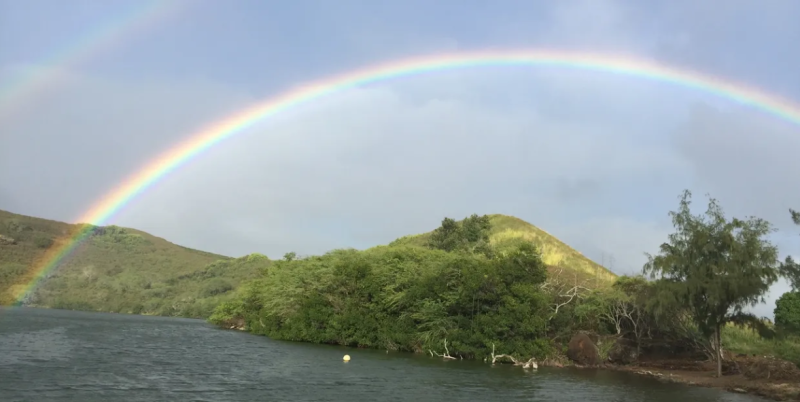Kauaʻi Sea Farms is located in an extinct volcanic caldera on the island of Kauaʻi. They are committed to restorative aquaculture and the preservation of Hawaii’s historic Nomilo Loko Iʻa, or Nomilo Fishpond. The Hawaiian family-owned and operated business combines modern sustainable aquaculture practices with ancient food production philosophies to grow clams, sea cucumbers, and edible seaweed.
Importing seed clams into Hawaii is not allowed, so Kauaʻi Sea Farms operates its own hatchery and nursery to ensure an ongoing supply. The clams are an East Coast species, Mercenaria mercenaria. It was introduced to Hawaiʻi in the 1960s, just before disease broke out on the East Coast. The relocation ensured that enough clams were removed from the mainland before they could be wiped out completely.
Although not a native species, the clams have a history of flourishing in Nomilo Fishpond (the only place in Hawaiʻi where they successfully reproduced). Many Kauaʻi residents have stories of eating or harvesting them and they remain a popular food item. Today, Kauaʻi Sea Farms is the only producer of Mercenaria mercenaria hard-shell clams in Hawaii.
A Focus on Sustainability
The ʻauwai (channels that connect the pond to the ocean) that fed clean water to the fishpond were cut off for 25 years after Hurricane Iniki in 1992. During this time, algae accumulated and the water became stagnant and extremely salty, causing populations of native species to drop.
In 2017, the family began removing sand and debris to reopen the ʻauwai, restarting the pond’s water exchange system. The pond is now rich with shoreline fish, such as ʻamaʻama (mullet), kaku (barracuda), moi (Pacific threadfin), ulua (giant trevally), pāpio (juvenile ulua), and tilapia. It is slowly reestablishing itself as an ideal habitat.
In addition to the fishpond’s regular operations, important research is being advanced at the farm. NOAA provided a Saltonstall-Kennedy grant that is enabling researchers to discover the ideal candidate species of loli (native Hawaiian sea cucumbers) for fishpond aquaculture. Sea cucumbers could potentially be grown throughout the United States, restoring ecosystems, serving as a valuable export, and reducing our reliance on imports.
Hawaiian Fishpond Kicks Off State’s First Sea Cucumber Aquaculture
From Farm to Table
The Nomilo Fishpond has been in the same family for more than 100 years. Production Manager David Anderson, who holds a Masters degree in Marine Biodiversity and Conservation, states that, “this farm is unique because throughout Hawaiian history, Western influences were taking away land starting in the mid-1800s. This is an important story of a place being re-acquired by a Hawaiian family, as not many of these places end up back under Hawaiian ownership. We are honoring the fishpond’s original purpose as a food security asset during the Kingdom of Hawaii.”
The farm’s clams and seaweed are popular menu items in many area restaurants. One unique and popular item is ʻākulikuli (Sesuvium portulacastrum), an edible native plant. It is a coastal ground cover with succulent leaves that are often used in salads and poke bowls.
Fun Fact
Kauaʻi Sea Farms is totally “off the grid.” Farm operations are all solar powered, with 70 kW of back-up batteries and a 14 kW propane back-up generator. The system is monitored and operated remotely, and designed to be expanded as operations grow.
Recipe: Nomilo Fishpond of Kauaʻi Curried Clams
Created by Chef Roy Yamaguchi, this recipe is a refreshing take on curried shellfish, even if you don’t have access to Nomilo clams.
Ingredients:
- 1 cup Curry Sauce (see below)
- 2 oz. Onion (medium diced)
- 2 oz. Sous Vide Pork Belly (cut into lardon size)
- 2 oz. Portuguese Sausage (linguiça)
- 32 Manila Clams (medium size)
- 3 oz. White Wine
- 4 oz. Chicken Stock
- Optional: Garnish with julienne bell peppers, julienne leeks, crispy garlic, fresh Thai basil and mint.
For Curry Sauce:
Makes 4 cups of sauce. Extra sauce can be stored in an airtight container for 2-3 days.
- 2 cans Coconut Milk (13.5 fl oz)
- 2 tbsp. Red Curry Paste
- 3 cups Chicken Stock
- ¼ cup Brown Sugar
- ½ cup Onion (medium diced)
- 2 tsp. Garlic (minced)
- 2 tsp. Ginger (minced)
- 2 tsp. Lemongrass (minced)
- 6 ea. Kaffir Lime Leaf
- 1 tbsp. Oil
Instructions:
- In a hot sauté pan (on high heat), sauté onions, pork belly and Portuguese sausage.
- Add clams and deglaze with white wine and chicken stock. Cover till clams start to open.
- Add 4 oz. of curry sauce and green onions.
- Once clams open fully, splash lime juice, toss, and transfer to a serving skillet.
Sources:
Sustainable Seafood from Tide to Table
The Tide to Table series profiles members of the aquaculture community, who provide valuable jobs and increase access to fresh, sustainably sourced American seafood. Aquaculture is more than seafood production. It is ecosystem stewardship, coastal communities, and economic opportunities.



